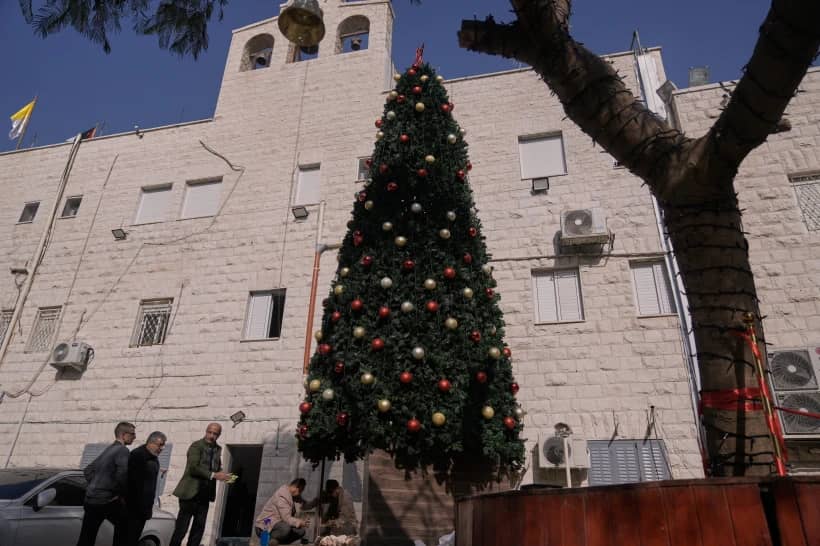ROME – Minutes before being hospitalized for intestinal surgery on Sunday, Pope Francis was given a pectoral cross made from wooden remains of a church in Chile destroyed by arson last year during street protests.
“There was a very strong and significant social outburst in Chile, with many reactions and violence,” said Bishop Alberto Lorenzelli, explaining the origin of the cross.
“Some churches were burnt down during the protests, including the church of the Assumption. Young people from the Catholic University collected the remains of burnt wood and they made the pectoral cross, as a relic they wanted to give to the Holy Father,” he said.
The bishop spoke with Crux over the phone on Thursday, from a hotel room where he’s been staying since flying back to Santiago, Chile’s capital, where he serves as auxiliary bishop. Due to COVID-19 restrictions, he has to isolate for two weeks.
“As I had a scheduled trip to Rome, they sent it to me, and I gave it to him, explaining its origins and the significance,” Lorenzelli said. “He was impressed, and very moved. And the fact that I gave it to him minutes before he headed for the hospital, I believe, was very significant.”
The prelate gave Francis the cross on Sunday, July 4, in the Santa Marta Residence, where the pope has lived since his election in 2013.
The cross was manufactured by students of the Duoc UC Institute of the Pontifical Catholic University of Chile. The institute is a formation center that teaches trades, and is mostly attended by students from lower income families.
The university estimates that 60 people were involved in the making of the pectoral cross: Twelve teachers, 25 students, 15 administrative staff and five directors.
Lorenzelli was tasked with hand-delivering the gift during a pre-scheduled trip to Rome by Father Samuel Arancibia, the chaplain of Duoc UC.
In a statement released by the Archdiocese of Santiago, the priest said the decision to craft the cross came when the young people volunteered to help clean the destroyed church and collected the debris caused by the roof collapse that happened during the fire.
“With one of those burnt beams we were able to make a pectoral cross, which is a very powerful sign,” Arancibia said. “It is a sign of victory and a response to violence through the cross of Christ.”
He also said that young people “from very different social realities” were involved in the gift, which shows that “just as there are those who destroy, there are others who are willing to build. In addition, the pope received this cross on the same day as the start of the Constitutional Convention, so there are many things that come together and that speak of a Church that is capable of rising up to show the strength of the cross of Christ.”
Chile’s Constitutional Convention is part of the process of re-writing the country’s constitution. It was called for through a referendum, and was one of the main outcomes of the civil revolt that began in 2019.
The spark for the movement had been the increase of 30 pesos, the equivalent at the time of 4 U.S. cents, in the cost of a subway card. The protests later morphed into a broad critique of the country’s economic model and high cost of living and culminated in the call for a new constitution to replace the one adopted during Augusto Pinochet’s notorious military dictatorship, which lasted from 1973 to 1990.
The violence of Oct. 18, 2020, when the churches were set ablaze, came as part of broad national demonstrations ahead of the referendum that determined the drafting of the new document.
Lorenzelli said the pectoral cross was significant “because it represents what Chile went through at that time, and at the same time, it has an enormous meaning because it represents the church that was burnt: Many were baptized, confirmed and got married or said goodbye to their loved ones in the Church of the Assumption.”
The bishop added, “It comes as no surprised that the pope was emotional when I gave it to him.”
Francis, known for his humble way of dressing, wears a silver pectoral cross that is the same he wore during most of his time as archbishop of Buenos Aires, Argentina. It’s design is rooted in the Gospel of Luke; specifically, the parable of the good shepherd and the lost sheep.
The wooden cross he received on Sunday has the visible marks of the fire on the front, but has been properly cleaned and polished on the back so as to not stain the cassock if the pontiff decides to wear it.
Follow Inés San Martín on Twitter: @inesanma















